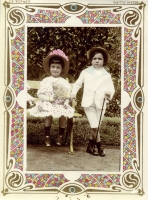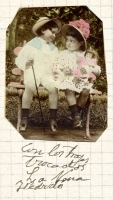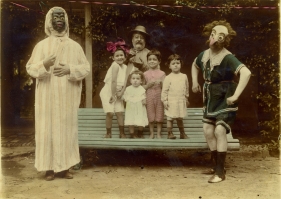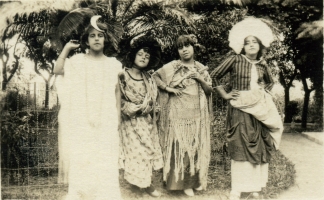The Oliver sisters with their friends the Graus dress up for Carnival, but during the year they specially have fun cross-dressing as men.
Josefina, with her friends, writes on her diary on January, 1895:
![]()
‘(…) Tuesday 22nd January – (…) After dinner we played the piano and danced -. Catalina, Elvira and Amelia dressed up as men and went along the street (…)’ Notes 1 p.070
In April 1897:
![]()
‘(…) Pastora, Ernestina, Alejandra came on the first train (…). We dressed up as men and Dad took a photo of us. We took some fresh air. After lunch Dad took photos of us again on a heap, on the stairs etc. (…)’. Notes 1 p.171
This interest must be inspired on the atmosphere of Buenos Aires by the end of the 19th C, when women were forbidden to walk alone during the day or go out at night without the company of a man, to study or to be trained for a job or a profession; in conclusion to lead their own lives and enjoy their interests.
In Europe, since the beginning of the 19th C there is a way of literary transvestism, behind which many female authors adopted male seudonyms to be read: George Sand (Aurore Dupin 1804-1876); Currer, Ellis and Acton Bell (the Brontë sisters: Charlotte, Emily, Anne, 1816-1855); George Eliot (Mary Anne Evans 1819-1880).
Or they live like the sculptress Camille Claudel (1864-1943), overshadowed by her lover (Auguste Rodin); or by her husband as the composer and pianist Clara Wieck Schumann (1819-1896), who states:
‘Some time I thought I had creative talent, but I have given up this idea; a woman mustn’t wish to compose. Not one has been able to do it, so why should I?’
In Argentina, some pioneer women lead a professional life, for which they suffer from endless taunting and harrying in newspapers and magazines, and become the perfect anti-models for their contemporaries.
As it happens to Juana Manso 1818-1875, Cecilia Grierson 1859-1934, Julieta Lanteri 1837-1932 or Juana Manuela Gorriti 1818-1892, who writes ‘the endless dificulties that skirts find in everything’.
In a case of gender substitution, contrary to the habitual ones of the time, Juana Gorriti supports Bernardo Demaría’s invention of publishing poems under the pseudonym Ema Berdier. Gorriti accompanies him by providing Ema with the face from a dead young beautiful woman, and sending her to get married in France to put her away from the scene. The publication of all this in the press enshrines the supposed female author, actually being Ema Berdier, a nonexistent writer.
Since 1887, Leopoldo Fregoli shines with all splendour on different international stages. He is a famous Italian artist who changes his voice, his costumes and his registry to bring to life dozens of characters, especially women. His success bursts in London, Paris, Barcelona, New York, Vienna, Berlin, Saint Petersburg and Buenos Aires.
In August 1897 Josefina writes:
![]()
‘(…) Sunday 15th – I got up at 9 and decked out. At 11, Pito came for me (…) and we went to the San Martin Theatre. Frégoli gifted chocolates, boxes, portraits, etc. It was the 1st time I saw him (…)’. Diary Notes 1 p.188
Carnival time always intensifies Josefina’s festive and transgressive nature, and together with the adverse context in which the woman develops in those years, affects her way of looking upon herself and others in reference to gender. She leaves us this account:
![]()
‘(…) Sunday 8th- Very nice day. Carnival’s burial. (…) Pepe went hunting and I dressed up as a man having a succès d'estime*. Pepe came a little later and I decked him out with a dress of mine, Porota wore her paper suit and after dressing up granddaddy ridiculously, we devoted ourselves to perpetuate the memory of our joke through photography. As the audience, all the people from the kitchen, Luis, his wife, his children and even the workman celebrating the scene (…)’. Diary 4, p.257 and 258, March 1908
*criticism success
Later Josefina sends a postcard to her sister Catalina, with her cross-dressed self-portrait, saying that it is a friend of Pepe, her husband. If we see these photos nowadays, the costume and the text are so convincing that if Josefina hadn’t been seen with the same suit in the former photo, her joke would have been absolutely believable.
On those carnival days, due to her final departure to Spain, she takes pictures of her nephews “with their suits exchanged”:
![]()
‘(…) Friday 25th – I have devoted the whole week to photograph views, interiors, portraits. Yesterday I took a picture of la nena as a boy and Pedrito as a girl. The day before yesterday I photographed Arito as a paperboy (…)’ Diary 4, p.413, February 1910


Her husband Pepe, also joins the game wearing Josefina’s swimming suit, together with her brother-in-law, Genaro García, with a negra mask:

Eight years later, on her back from Spain and during a carnival day in Adrogué, province of Buenos Aires, her son Pedrito appears as an old lady:


Five years later, in Mallorca, she notes down:
![]()
‘(…) Monday 3rd - … I took some pictures of the children today. Beleta with a shawl and a big comb, Juanita as a boy and Pedrito as a little girl. He was really gorgeous. (…)’ Diary 6, p.320
![]()
‘(…) Sunday 16th - … At 11 I dressed up the three children with shawls and Pedrito as a woman and I took several portraits of them. Isabel R and Miguel came with Joanet. We also dressed up the latter as a girl and I took some pictures of them.(…)’ Diary 6, p.323, September 1923